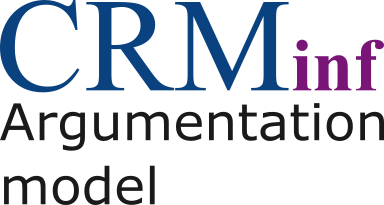|
What is the CRMinf? CRMinf is a formal ontology intended to be used as a global schema for integrating metadata about argumentation and inference making in descriptive and empirical sciences such as biodiversity, geology, geography, archaeology, cultural heritage, conservation, research IT environments and research data libraries. Its primary purpose is facilitating the management, integration, mediation, interchange and access to data about reasoning by a description of the semantic relationships between the premises, conclusions and activities of reasoning. CRMinf uses and extends the CIDOC CRM (ISO21127) as a general ontology of human activity, things and events happening in space-time. It uses the same encoding-neutral formalism of knowledge representation (“data model” in the sense of computer science) as the CIDOC CRM, which can be implemented in RDFS, OWL, on RDBMS and in other forms of encoding. Since the model reuses, wherever appropriate, parts of CIDOC Conceptual Reference Model, we provide in this document also a comprehensive list of all constructs used from ISO21127, together with their definitions following the version 5.1.2 maintained by CIDOC. The CRMinf has been approved by CRM SIG |
What is the idea? CRMinf is motivated and has been validated by examples of argumentation about facts (in contrast to categorical theory building) from archaeological reasoning and reasoning on text elements and annotations in manuscripts. It takes further into account reasoning about facts in scientific data in the form of observation, measurement, data evaluation and citation in biodiversity, geology, archeology, cultural heritage conservation and clinical studies. Besides application-specific extensions, this model is intended to be complemented by CRMsci, a more detailed model and extension of the CIDOC CRM for metadata about scientific observation, measurements and processed data in descriptive and empirical sciences. CRMinf is an attempt to maintain a modular structure of multiple ontologies related and layered in a specialization – generalization relationship, and into relatively self-contained units with few cross-correlations into other modules, such as describing quantities. This model aims at staying harmonized with the CIDOC CRM, i.e., its maintainers submit proposals for modifying the CIDOC CRM wherever adequate to guarantee the overall consistency, disciplinary adequacy and modularity of CRM-based ontology modules. |


